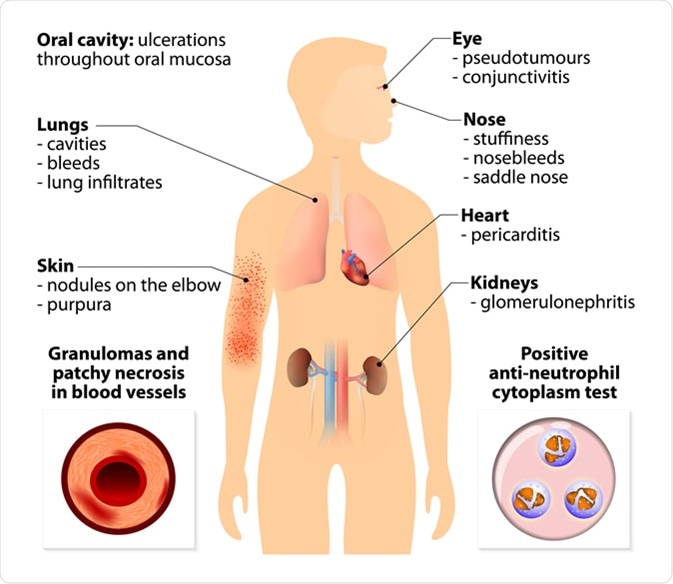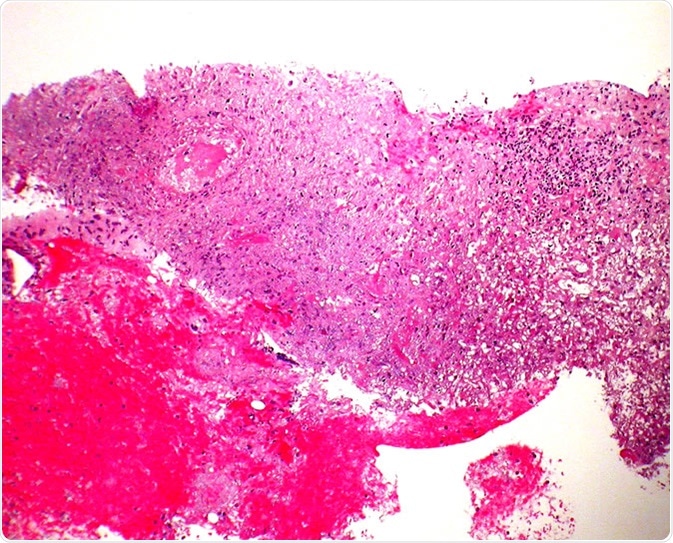Skip to
- Why does GPA develop?
- Symptoms of GPA
- How is GPA diagnosed?
- How is GPA treated?
- Risk Factors for GPA
- What is the prognosis for GPA?
Granulomatosis with polyangiitis (GPA), known as Wegener’s granulomatosis until 2011, is a rare and potentially serious condition that causes inflammation of the small blood vessels and capillaries. It typically affects the ears, nose, sinuses, kidneys, and lungs, and can affect anyone of any age, although it is most commonly seen in middle-aged or elderly people.

Why does GPA develop?
GPA is an autoimmune disease but its cause is not clear at present. It is believed that a faulty immune response causes antibodies to mistakenly attack the blood vessels, leading to inflammation.
Antineutrophil cytoplasmic antibodies (ANCAs) have been found to be present in most patients with GPA. These ANCAs activate certain types of white blood cell that leads to the inflammation characteristic of the condition. The ANCAs attach to the neutrophils in the blood, promoting their attachment to the wall of the blood vessel and stimulating the release of various pro-inflammatory chemicals. The reason for the development of ANCA is not clear as of now.
Some research suggests that exposure to silica, or contracting an infection with the bacterium Staphylococcus aureus (commonly known as Staph), can lead to GPA, but these links have not been definitively proved.
It is also believed to be likely that those who develop GPA have a gene that predisposes them to the condition, but as it is uncommon for two people in the same family to have GPA, it is not thought that genes are solely responsible for its onset.

Symptoms of GPA
The symptoms of GPA vary, depending on which part of the body is affected. General symptoms include fatigue, a high temperature, weakness, a loss of appetite, weight loss, and pain in the joints.
Symptoms affecting specific parts of the body are listed below.
Symptoms in the ear, nose, and throat
- Blocked or runny nose
- Nosebleeds
- Crusts around the nostrils
- Sinusitis (facial pain)
- Earache
- Hearing loss.
Symptoms in the lungs
- A persistent cough
- Shortness of breath
- Wheezing
- Chest pain.
Renal symptoms
- Blood in the urine
- High blood pressure
- Glomerulonephritis (inflammation of the kidneys).
Skin symptoms
- Rashes
- Lumps
- Necrosis (death of tissue)
- Ulcers
- Small purple spots.
Ocular symptoms
- Conjunctivitis
- Bloodshot eyes
- Swollen eyelids
- Dry eyes
- Loss of vision
- Double vision.
Gut symptoms
- Stomach pain
- Diarrhea
- Blood in stool
Neurologic symptoms
- Loss of sensation
- Weakness
- Hotness in the hands and feet
- Pins and needles in the hands and feet
- “Electric shocks” in the hands and feet.
How is GPA diagnosed?
It is not easy to diagnose granulomatosis with polyangiitis due to the nonspecific nature of the symptoms, which mimic a number of more common conditions.
A specialist may be able to diagnose granulomatosis with polyangiitis from the medical history and a careful physical examination. Urine tests to check kidney function and blood tests to look for ANCAs may be ordered in most cases where the suspicion of GPA arises.
A biopsy (a small tissue sample) from the kidneys or lungs may be ordered to identify signs of inflammation if these are involved.
A number of imaging technologies are used to diagnose the condition. X-rays, CT (computerized tomography) scans or MRI (magnetic resonance imaging) scans allow specialists to examine affected parts of the body.
How is GPA treated?
The treatment of granulomatosis with polyangiitis is organized into three stages.
Stage one
The drugs administered in stage one aim to suppress the immune system.
Patients will be given injections of certain immunosuppressive drugs every two to three weeks, or the drug can be taken as a tablet every day. Sometimes monoclonal antibody drugs will be used instead.
Daily steroid tablets or steroid injections into the blood will also be used along with the immunosuppressant treatments. However, side effects must be discussed with a health professional because these drugs are highly potent.
Some patients will need a plasma exchange in stage one. This is a procedure in which the blood is filtered to remove any harmful antibodies linked to granulomatosis with polyangiitis.
Stage two
Once a patient’s symptoms are under control, stage two of their treatment will include continuing with daily steroid medication. Less potent immunosuppressants are prescribed for the maintenance phase of treatment.
Stage two may last for between two to five years.
Stage three
If symptoms recur (which is called a relapse), the treatment plan will either be changed or restarted.
Risk Factors for GPA
GPA most commonly affects middle-aged and elderly people, but it has been observed to occur in young adults and children. There is no difference in the incidence in men or women.
What is the prognosis for GPA?
The prognosis of the condition depends on its severity, and in particular, whether extensive damage has occurred to the organs, in particular the kidneys.
About half the patients may experience relapses of the condition after the end of the first course of treatment, making a careful follow up mandatory.
Sources
- Vasculitis.org Wegener's granulomatosis – now renamed granulomatosis with polyangiitis (GPA). http://www.vasculitis.org.uk/about-vasculitis/wegeners-granulomatosis
- Nhs.uk Granulomatosis with polyangiitis (Wegener's granulomatosis). https://www.nhs.uk/conditions/granulomatosis-with-polyangiitis/
- Rarediseases.info Granulomatosis with polyangiitis (2018). rarediseases.info.nih.gov/…/granulomatosis-with-polyangiitis
- MedlinePlus Granulomatosis with polyangiitis. https://medlineplus.gov/granulomatosiswithpolyangiitis.html
Further Reading
- All Granulomatosis with Polyangiitis Content
Last Updated: May 20, 2019

Written by
Lois Zoppi
Lois is a freelance copywriter based in the UK. She graduated from the University of Sussex with a BA in Media Practice, having specialized in screenwriting. She maintains a focus on anxiety disorders and depression and aims to explore other areas of mental health including dissociative disorders such as maladaptive daydreaming.
Source: Read Full Article
